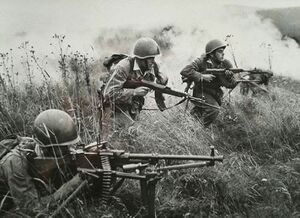User:Sandoria/Sandbox3
| Miersan War | |||||||
|---|---|---|---|---|---|---|---|
 East Miersan forces occupying Bełskie, Ziarnokosz, 1980 | |||||||
| |||||||
| Belligerents | |||||||
|
|
| ||||||
| Commanders and leaders | |||||||
|
|
| ||||||
| Units involved | |||||||
| 270,000 | 201,000 | ||||||
The Miersan War (Miersan: Wojna Mierska) was an armed conflict between East Miersa and West Miersa from 1980 to 1981. The war resulting in the shelling of West Zobrodz, and the invasion of West Miersa. The northern regions were taken swiftly whilst in the south Eastern forces were defeated. The war ended with a partial East Miersan victory, annexing land from the West, despite their goal of unifying Miersa not being met.
After the Rose Revolution in the East occured, throughout the 1970s, mass protests and uprisings by minority groups inspired by the Eastern revolution occured across West Miersa. Alongside this, West Miersan and East Miersan forces had been battling each other in a series of border clashes, further escalating the tensions between the two nations. These border clashes resulted in an ultimatum by the East to demilitarise immediately. West Miersa's government, then led by Sylwester Petroski, refused.
On [DATE] 1980 the East began a massive bombardment of West Zobrodz. This was followed by Eastern forces beginning and invasion of the West, initially in the region of Ziarnokosz in the north. This was followed by invasion of the region of Zanawiwasie shortly after. West Miersan forces were taken by surprise and quickly pushed back in these regions, cities like Belskie and Rycerow fell quickly to the invading forces.
In the north West Miersan resistance failed to stop the region from falling, more resistance was seen in the southern parts of the country. By 1981 the city of West Zobrodz began to be besieged by the East. In the south, Eastern forces would attempt to take the cities of Damsyl and Tarclaw, but were bogged down and eventually stopped.
In April 1981 a counteroffensive began to take shape in the south. Eastern forces were pushed back into Zanawiwasie and eventually the city of Rycerow was retaken by the West. In the north the counteroffensive was less successful, taken only small amounts of land before being bogged down. West Zobrodz eventually finally fell in the Autumn of 1981, afterwards the West would sign a ceasefire with the East. The West would lose the city of Zobrodz, and the region of Ziarnokosz, and some small patches of land in the south in a costly victory for the East.
The war would have profound effects on both nations and Euclea as a whole. In the east the war led to the end of the revolutionary radicalism that had begun with the Rose Revolution heralding a era of national reconstruction and severe austerity as the economy entered prolonged stagnation. In the west the war led to the rise of Kazimierz Glogowski and the beginning of the Lemovician War heralding a period of foreign policy isolationism and political and ethnic violence.